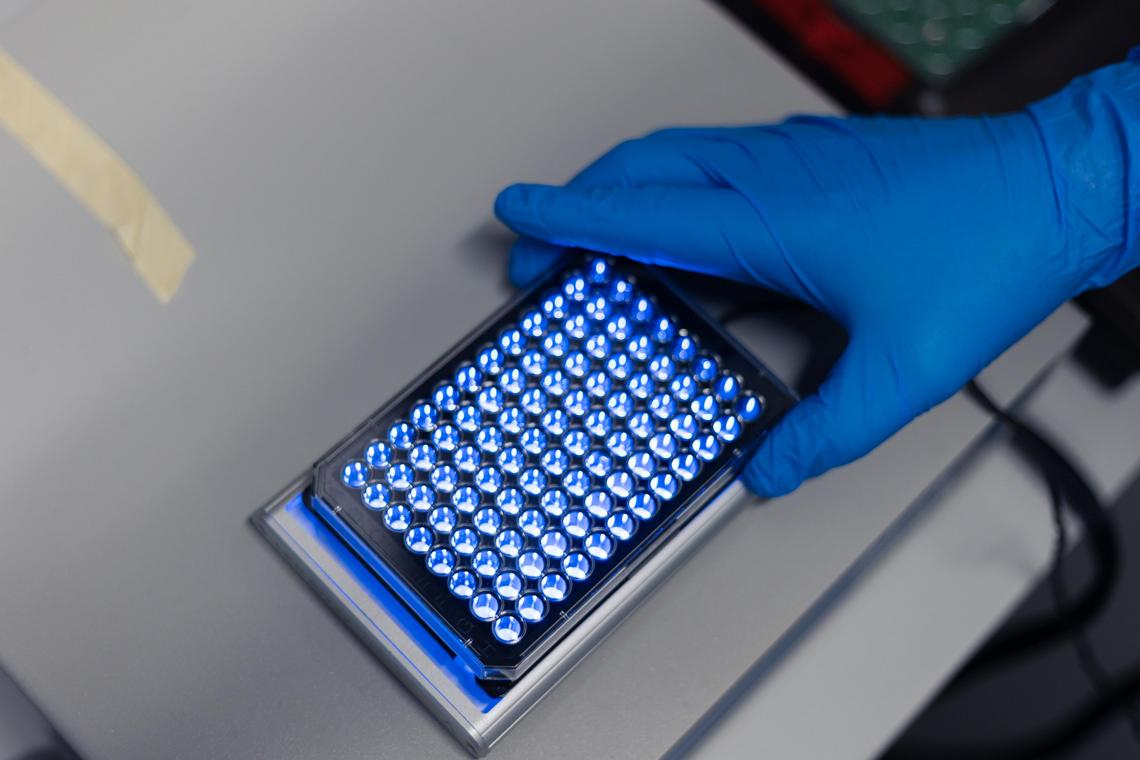A research project led by the IMC University of Applied Sciences Krems has just been successfully completed and now provides an excellent basis for further projects: The team led by Prof. Christoph Wiesner from the Institute of Biotechnology has succeeded in genetically modifying special receptors (Toll-like receptors, TLRs) on stem cells so that they can be activated by blue light. Such "optogenetic" techniques could be used to precisely control biological signalling pathways in cells, validated them under physiologically relevant conditions and generate disease models. These new optogenetic cell lines will also make a valuable contribution to the understanding of disease mechanisms and the development of innovative, targeted therapeutic approaches.
Press
Optogenetics: "Light Switch" for Special Receptors Developed

For several years, the group led by Christoph Wiesner, holder of the "Cellomics / High Content Screening" research professorship at the IMC Krems, has been focusing on optogenetics – an emerging field of research that deals with the targeted control of cells using light. The aim of the project, which has now been successfully completed and was funded by the Austrian Research Promotion Agency – FFG – österreichische Forschungsförderungsgesellschaft – was to develop new stem cell lines (MSCs, mesenchymal stromal cells) whose receptors have been genetically modified by incorporating light-sensitive proteins so that they can be activated by blue light.
MSCs Are All-Rounders
"In our project," explains Prof Wiesner, "we worked with so-called MSCs, or mesenchymal stromal cells. These are adult stem cells that can be found in a variety of tissues and can differentiate into different cell types.” MSCs are found in the body in two different states (MSC1 and MSC2), which have different functions: The MSC1 cells have a pro-inflammatory effect, i.e. they promote inflammatory reactions and thus support the immune system to fight infections and tumours. The anti-inflammatory MSC2 cells, on the other hand, dampen inflammatory responses in the body and are therefore useful in chronic inflammation, autoimmune diseases or to promote tissue repair after injury. It is known that all MSCs carry special receptors on their cell surface – "Toll-like receptors" (TLRs) – that recognise their molecular pattern on contact with pathogens and trigger an immune response via subsequent signalling pathways. However, the exact mechanisms by which the activation of different TLRs leads to the development of the two forms of MSCs are still poorly understood – a fact that Prof Wiesner's research team has addressed.
A Question of Regulation
Based on the hypothesis that MSCs can take on different functions depending on the activated TLR type and the strength of the stimulus (e.g. pro- and anti-inflammatory, antibacterial or regenerative tasks), transgenic and optogenetic approaches should help to elucidate the mechanisms that lead to the polarisation of MSCs into the two forms MSC1 and MSC2. "To do this, we incorporated light-sensitive proteins into the TLRs so that we could switch the receptors on by light and off again by darkness," explains Prof. Wiesner. In particular, it was shown that TLR4 and TLR10 could be easily controlled by light after incorporation into the cell lines. The following observations proved that the optogenetic constructs worked perfectly: TLR4 activation led to the production of pro-inflammatory molecules, similar to bacterial infection, while TLR10 activation regulated both pro- and anti-inflammatory molecules. Extensive analysis of the supernatant of the cultured MSC cell lines revealed numerous proteins indicative of the cells´ regenerative potential and accelerated bone cell formation after TLR10 activation. This makes the new cell lines useful tools for investigating the mechanisms of TLR4 and TLR10 activation and may provide new approaches for therapeutic strategies.
Stem Cells in “Serial Production”
The ESPRIT project with Anna Stierschneider, Senior Postdoc in Christoph Wiesner's research group, in which miniaturised (0.2-0.5 mm in size), physiologically relevant 3D heterotypic cell models are established in vitro, shows that the new optogenetic cell lines can be tested in more than just individual experiments. The optogenetic stem cells are integrated into heterotypic tumour cells (colorectal adenocarcinoma), 96 of these miniaturised tumours are cultivated in parallel and the optogenetic approach is tested for its anticarcinogenic potential. Initial experiments are promising.
1 Project – Many Opportunities
The successfully completed project has not only resulted in three published studies, but also in further research projects and valuable collaborations – including the follow-up project ESPRIT, which is funded by the Austrian Science Fund - FWF (Österreichischer Wissenschaftsfonds) - and a training programme for doctoral students (doc.funds), which the IMC Krems is coordinating with the University for Continuing Education Krems and MedUni Vienna. Together with ABS Biotechnology GmbH, a GFF application was submitted to introduce optogenetic constructs into inducible pluripotent cells and investigate their effects on cardiac myocytes and macrophages. In collaboration with KL Krems and the UPEC University (Paris), the effect of TLR-activated mesenchymal stem cell supernatants on neurons and in Alzheimer's disease models will be investigated.
